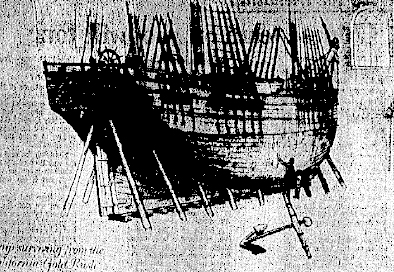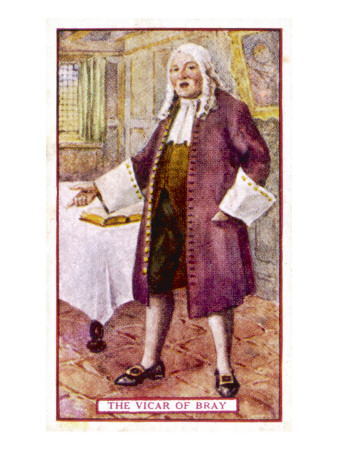The Vicar of Bray was built by Robert Hardy at Whitehaven and was launched on the 22nd April 1841. The Vicar of Bray was his penultimate large vessel, being followed only by the brig Hyperion, in 1844.
The barque had a high classification at Lloyd’s, 12 years A1, indicating good quality materials and workmanship. Her survey report stated that she was “as good as can be made,” and that she had been built of English oak and West African hardwoods.
On the 16th June 1841 the Vicar of Bray entered Liverpool for loading, and a month later she departed the Mersey, under the command of Capt. Seymour and bound for Rio de Janeiro and Lima. The round trip took a year, and the vessel entered inwards at the London Custom House on the 1st July 1842.
Newspaper reports show the Vicar of Bray arriving at Cowes, Isle of Wight, on the 8th February 1849, from Huanchaco, then departing Gravesend on the 27th March, for Valparaiso. In November/December she arrived at San Francisco from Valparaiso, under the command of Capt. Duggan. Her crew apparently deserted her upon arrival, and it took some time before Capt. Duggan could find replacements.
On the 1st October 1850 the barque was reported sailing from Callao, bound for Liverpool. Oddly, in March 1850 the Times carried an advertisement for the Vicar of Bray, C. Duggan commander, to sail from London on the 10th October, as one of several vessels offering a regular packet service to San Francisco. The vessels were advertised as having excellent accommodation for passengers, and were said to be “favourably known in the Pacific”.
Daily Alta California,
Advertisements:
February 18, 1850, February 21, February 26, February 27, 1850
FOR VALPARAISO. Will sail in a few days, the fine fast sailing Brits-built bark Vicar of Bray, A 1 for 12 years, C. B. Duggan master.
For particulars of freight or passage, having superior accommodations, apply to PROBST, SMITH & CO., California street. 15f

Daily Alta California, February 27, 1850
March 11, 1850, Daily Alta California: The English bark Vicar of Bray, Duggan, cleared Valparaiso.
An advert appeared in July 1852, for the “well-known clipper barque Vicar of Bray“, Robert Harrison commander, lying at St. Katherine’s Dock and seeking cargo and passengers for Valparaiso. Her agent was George Seymour, of Cornhill.
In March 1870 the barque, Capt. Lewis, arrived at Bristol from Mauritius with a cargo of 6737 bags of sugar. She then went to Cardiff to load a cargo of 29 tons of machinery and 436 tons of coal, and cleared for Valparaiso on the 25th May. The Vicar of Bray, along with several other vessels, was damaged in a storm, with loss of sails and boats, and damage to the bulwarks and stanchions, and was forced to put into Port Stanley in the Falkland Islands to discharge her cargo and undergo repairs. The barque was bought by the Falkland Islands Company in 1873, and seems to have been refitted for trading between London and the Falklands.
Her career came to an end when she arrived at Stanley from London on the 23rd September 1880. Her entry in Lloyd’s Register that year was appended with the note “Now a Hulk.” Her hull was used as a jetty at Goose Green, and today, partly submerged, still survives there.
~ ~ ~ ~
Hayward Daily Review, April 23, 1972
Redlands Daily Facts, May 25, 1972
By JAMES O. CLIFFORD SAN FRANCISCO from UPI
San Francisco may be about to add another vessel to its fleet of historic ships, which is probably the finest in the nation. The flotilla is berthed in the Fisherman’s Wharf area and attracts thousands of visitors each year. The vessels include the Balclutha, a typical Cape Horner of the 1880′s, the threemasted lumber schooner C. A. Thayer, the steam schooner Wapama, the scow schooner Alma, and the ferryboat Eureka.
There’s lots more and Karl Kortum, director of the San Francisco Maritime Museum, says there’s more to come. Also available for the nautical fan in San Francisco is the paddle tug Eppleton Hall, an English vessel of early 1900s vintage that steamed from England to San Francisco in 1969-1970. In the Museum’s building, housing models and other maritime displays, is the tiny Mermaid in which Kenichi Horie made his famous singlehanded voyage from Japan to San Francisco in 1962.
Kortum thinks he has one of the greatest finds ever in the Vicar of Bray, the only surviving Gold Rush sailing ship.
Kortum discovered the Gold Rush ship in 1966 on a visit to the Falkland Islands. Now used as a mooring facility and decimated in many quarters, Kortum says that from the waterline up the hull is amazingly intact. “The find is equivalent to locating Drake’s Plate of Brasse or the Golden Spike,” Kortum said. “We will indeed find a place for her in San Francisco and bring her home in sections as deck cargo, if need be.”
Museum president Norman Scott would like to see a building constructed “for her care in the same manner that Sweden houses the Vasa.” The Vasa, a 350-year-old Swedish man-of-war, has become the major tourist attraction in Sweden.
 Desertions from the Gold Rush ships in San Francisco, which resulted in a “ghost fleet” left idle in the bay, are legendary. The sailors joined the army of miners and headed for the gold fields. The Vicar of Bray alone survives from the thousands of ships that sailed forth to the gold fields.
Desertions from the Gold Rush ships in San Francisco, which resulted in a “ghost fleet” left idle in the bay, are legendary. The sailors joined the army of miners and headed for the gold fields. The Vicar of Bray alone survives from the thousands of ships that sailed forth to the gold fields.
Even the Vicar of Bray’s crew was not entirely immune to the lure of gold.
“Amazingly, the original articles for the Vicar of Bray’s voyage to San Francisco still survive,” Kortum said. “We have obtained a photostat of these from the Registrar-General of Shipping and Seamen” in Wales.
The records show that three days after arriving here five men jumped ship.
~ ~ ~ ~
“Vicar of Bray” is a most interesting name for a vessel. The term comes from a spoof on vicars dating back to the time of Henry VIII; it has been reenacted as a play through the years.
The following lyric is a version of the song recorded by Richard Dyer-Bennet in 1955:
In good King Charles’ golden time, when loyalty no harm meant,
A zealous high churchman was I, and so I gained preferment.
To teach my flock, I never missed: Kings are by God appointed
And damned are those who dare resist or touch the Lord’s annointed.
(Chorus)
And this be law, that I’ll maintain until my dying day, sir
That whatsoever king may reign, Still I’ll be the Vicar of Bray, sir.
When royal James possessed the crown, and popery came in fashion,
The penal laws I hooted down, and read the Declaration.
The Church of Rome, I found, did fit full well my constitution
And I had been a Jesuit, but for the Revolution.
When William was our King declared, to ease the nation’s grievance,
With this new wind about I steered, and swore to him allegiance.
Old principles I did revoke; Set conscience at a distance,
Passive obedience was a joke, a jest was non-resistance.
|
When Royal Anne became our queen, the Church of England’s glory,
Another face of things was seen, and I became a Tory.
Occasional conformists base; I blamed their moderation;
And thought the Church in danger was from such prevarication.
When George in pudding time came o’er, and moderate men looked big, sir
My principles I changed once more, and I became a Whig, sir.
And thus preferment I procured From our new Faith’s Defender,
And almost every day abjured the Pope and the Pretender.
The illustrious house of Hanover and Protestant succession
To these I do allegiance swear – while they can hold possession.
For in my faith and loyalty I never more will falter,
And George my lawful king shall be – until the times do alter.

